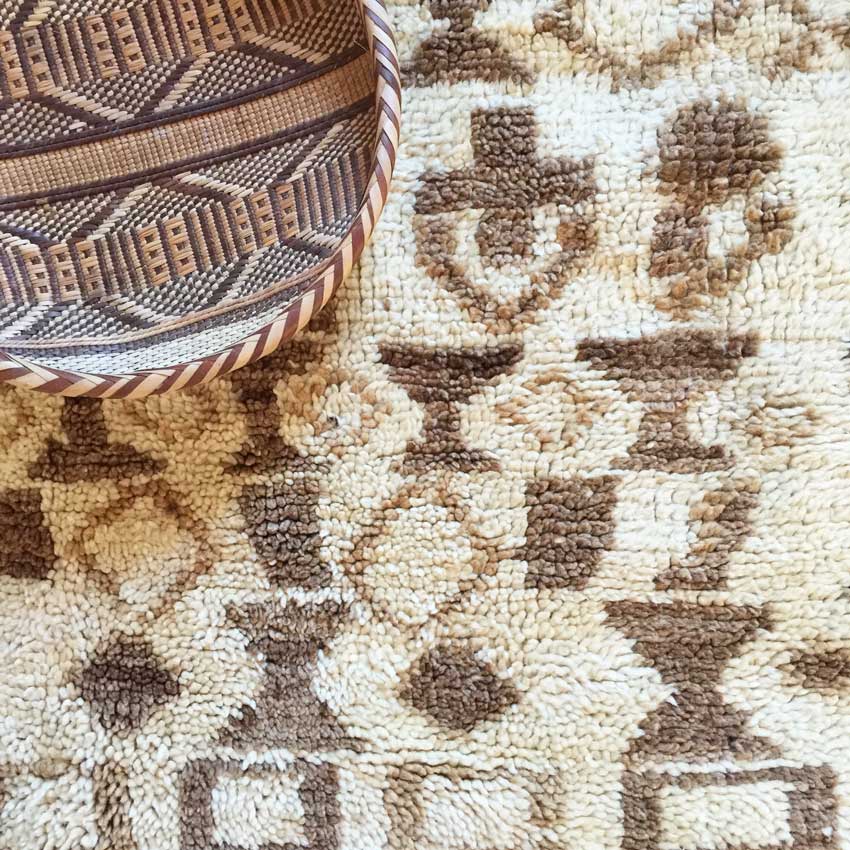Moroccan Carpet Care and Cleaning
Your rug will need regular care
Moroccan tribal carpets are utilitarian art pieces designed to warm the home, act as a bed or seating, and show off the weaver’s skills. They were crafted by people who believed in the power of signs and symbols. Moroccan carpets are loosely woven, with a much lower knot count than Persian rugs. Your rug will need regular maintenance and care that should reflect its soft, artisanal nature
Moths are enemies of Moroccan carpets!
Moths love rugs because large, hand-knotted rugs are wide-open sources for them to feast on. Wool rugs are HIGHLY susceptible to moth infestations, as their larvae feed on protein in animal-based fabrics like wool. Treat your carpet on both sides with a moth killer spray, and keep a careful watch on it to check that moths and bugs have gotten into it. By routinely inspecting, rotating, airing, and cleaning your rug, you will make it uninhabitable for moths. Look on both sides to check for white casings or webbing - that will show larvae may be present. Vacuum the carpet back and front: regular vacuuming is one of the best preventative measures. Look at your rug if parts of it are under a table, a sofa, or a bed: moths head for these undisturbed areas. Take special care if you are laying a rug on top of a fitted wool carpet as moths like to live between the two carpets. Keep your rug clean, and never roll and store a dirty rug, always clean it first. Even then, moths will get into a stored rug if you don’t regularly open it and shake or vacuum it
Any authentic vintage carpet will have wear, markings or unravelling, and this is natural and indicates true age. Any significant damage to your Maroc Tribal carpet will have been made good before it is sent to you. Further than that, the signs of wear or colour runs are an honest indication of your carpet’s past life. Many rugs will shed wool, particularly contemporary ones. This usually settles down after a few months and is very common in Moroccan rugs
Use a rug pad
Most Moroccan carpets benefit from being laid on a rug pad. This protects the carpet by supporting the knotted pile from damage, makes it more comfortable to walk on, and maximises grip where it may be prone to slipping. The sort of rug pad you buy depends on whether you are laying the carpet on hard (stone /wood) or soft floors and fitted carpet. You can usually cut pads to the size of your rug. A high-performance non-slip rug pad should offer cushioning while allowing the rug to lay flat. A thickness of about 3mm to 5mm should be about right for a low-pile vintage rug, although using a pad that is too thick can cause wrinkles in your carpet
We can arrange for professional cleaning
There will come a time when your carpet will need a full clean. We can arrange for your rug to be professionally cleaned (and repaired if necessary) Contact us on 07480222778 or info@maroctribal.com and we will help
For spot cleaning to remove a spill, you can use a damp cloth and a small amount of very gentle detergent. You can wash some rugs in the bath if you have some space and strength, then dry it in the sun. Do a spot test first, to check that no colours will run. Other than when your carpet might be airing or drying outside, try to keep it out of direct sunlight to avoiding fading. Original old carpets will drop some carpet dust onto the floor beneath them and this is quite normal
We hand wash each Maroc Tribal carpet before it is sold, and each will have had a light spritz of domestic moth treatment. Mostly we wash our carpets here in the UK to avoid them being washed in Morocco’s ecologically sensitive rivers with detergents we aren’t sure about



